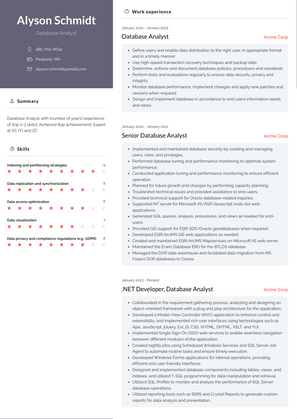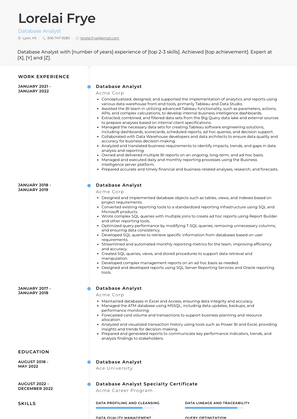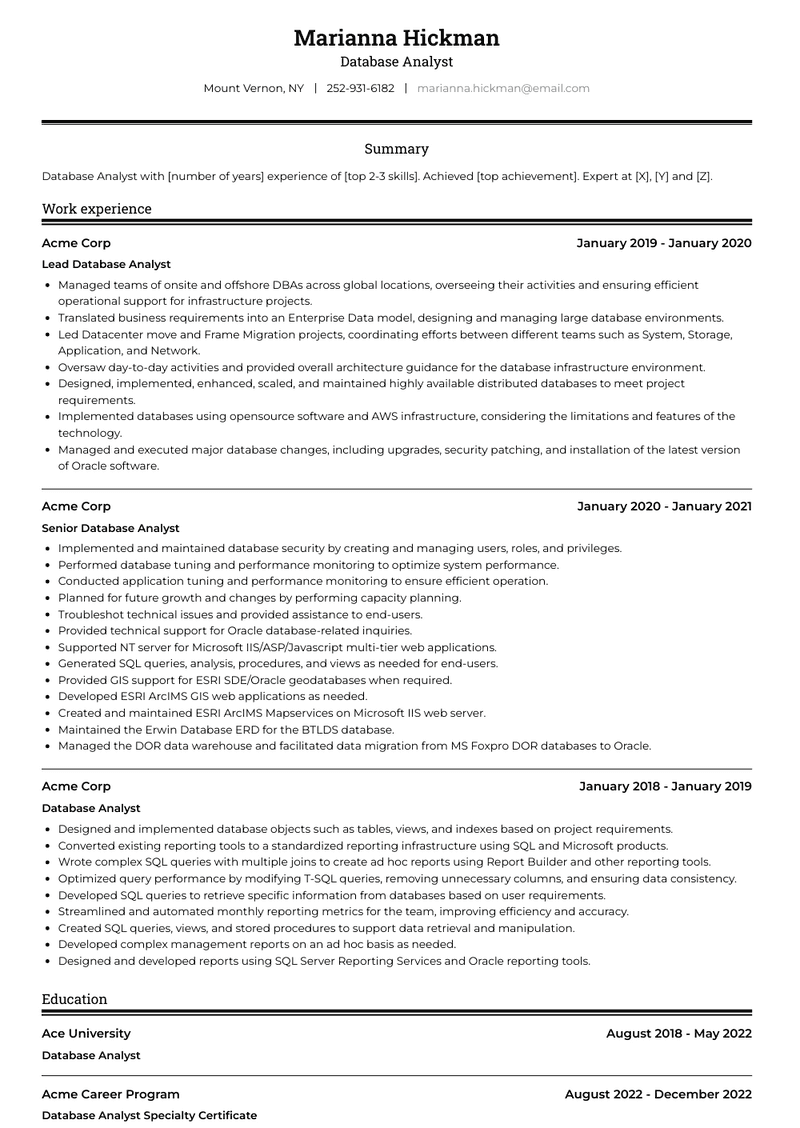Database Analyst Resume Examples and Templates
This page provides you with Database Analyst resume samples to use to create your own resume with our easy-to-use resume builder. Below you'll find our how-to section that will guide you through each section of a Database Analyst resume.



What Do Hiring Managers Look for in a Database Analyst Resume
- Proficient in analyzing, organizing, and managing data within a database system.
- Strong knowledge of database management concepts, data modeling, and SQL querying.
- Skilled in designing and implementing database structures and schemas.
- Ability to perform data profiling, cleansing, and data quality assurance.
- Proficiency in generating reports, analyzing database performance, and providing insights for decision-making.
How to Write a Database Analyst Resume?
To write a professional Database Analyst resume, follow these steps:
- Select the right Database Analyst resume template.
- Write a professional summary at the top explaining your Database Analyst’s experience and achievements.
- Follow the STAR method while writing your Database Analyst resume’s work experience. Show what you were responsible for and what you achieved as a Database Analyst.
- List your top Database Analyst skills in a separate skills section.
How to Write Your Database Analyst Resume Header?
Write the perfect Database Analyst resume header by:
- Adding your full name at the top of the header.
- Add a photo to your resume if you are applying for jobs outside of the US. For applying to jobs within the US, avoid adding photo to your resume header.
- Add your current Database Analyst position to the header to show relevance.
- Add your current city, your phone number and a professional email address.
- Finally, add a link to your portfolio to the Database Analyst resume header. If there’s no portfolio link to add, consider adding a link to your LinkedIn profile instead.
Bad Database Analyst Resume Example - Header Section
Aisha 7600 W. Bay Meadows Avenue Rochester, NY 14606 Marital Status: Married, email: cooldude2022@gmail.com
Good Database Analyst Resume Example - Header Section
Aisha Oneill, Rochester, NY, Phone number: +1-555-555-5555, Link: linkedin/in/johndoe
Make sure to add a professional looking email address while writing your resume header. Let’s assume your name is John Doe - here is a formula you can use to create email addresses:
- firstnamelastname@email.com - johndoe@email.com
- firstname.lastname@email.com - john.doe@email.com
- lastname.firstname@email.com - doe.john@email.com
- f.lastname@email.com - j.doe@email.com
- l.firstname@email.com - d.john@email.com
- firstnamelastname12@email.com - johndoe12@email.com
For a Database Analyst email, we recommend you either go with a custom domain name (john@johndoe.com) or select a very reputed email provider (Gmail or Outlook).
How to Write a Professional Database Analyst Resume Summary?
Use this template to write the best Database Analyst resume summary: Database Analyst with [number of years] experience of [top 2-3 skills]. Achieved [top achievement]. Expert at [X], [Y] and [Z].
How to Write a Database Analyst Resume Experience Section?
Here’s how you can write a job winning Database Analyst resume experience section:
- Write your Database Analyst work experience in a reverse chronological order.
- Use bullets instead of paragraphs to explain your Database Analyst work experience.
- While describing your work experience focus on highlighting what you did and the impact you made (you can use numbers to describe your success as a Database Analyst).
- Use action verbs in your bullet points.
.NET Developer, Database Analyst Resume Example
.NET Developer, Database Analyst
- Collaborated in the requirement gathering process, analyzing and designing an object-oriented framework with a plug and play architecture for the application.
- Developed a Model-View-Controller (MVC) application to enhance control and extensibility, and implemented rich user interfaces using technologies such as Ajax, JavaScript, jQuery, Ext JS, CSS, XHTML, DHTML, XSLT, and YUI.
- Implemented Single Sign-On (SSO) web services to enable seamless navigation between different modules of the application.
- Created nightly jobs using Scheduled Windows Services and SQL Server Job Agent to automate routine tasks and ensure timely execution.
- Developed Windows Forms applications for internal operations, providing efficient and user-friendly interfaces.
- Designed and implemented database components including tables, views, and indexes, and utilized T-SQL programming for data manipulation and retrieval.
- Utilized SQL Profiler to monitor and analyze the performance of SQL Server database operations.
- Utilized reporting tools such as SSRS and Crystal Reports to generate custom reports for data analysis and presentation.
Database Analyst Resume Example
Database Analyst
- Define users and enable data distribution to the right user, in appropriate format and in a timely manner
- Use high-speed transaction recovery techniques and backup data
- Determine, enforce and document database policies, procedures and standards
- Perform tests and evaluations regularly to ensure data security, privacy and integrity
- Monitor database performance, implement changes and apply new patches and versions when required
- Design and implement database in accordance to end users information needs and views
Database Analyst Resume Example
Database Analyst
- Conceptualized, designed, and supported the implementation of analytics and reports using various data warehouse front-end tools, primarily Tableau and Data Studio.
- Assisted the BI team in utilizing advanced Tableau functionality, such as parameters, actions, APIs, and complex calculations, to develop internal business intelligence dashboards.
- Extracted, combined, and filtered data sets from the Big Query data lake and external sources to prepare analyses based on internal client specifications.
- Managed the necessary data sets for creating Tableau software engineering solutions, including dashboards, scorecards, scheduled reports, ad hoc queries, and decision support.
- Collaborated with Data Warehouse developers and data architects to ensure data quality and accuracy for business decision-making.
- Analyzed and translated business requirements to identify impacts, trends, and gaps in data analysis and reporting.
- Owned and delivered multiple BI reports on an ongoing, long-term, and ad-hoc basis.
- Managed and executed daily and monthly reporting processes using the Business Intelligence server platform.
- Prepared accurate and timely financial and business-related analyses, research, and forecasts.
Senior Database Analyst Resume Example
Senior Database Analyst
- Implemented and maintained database security by creating and managing users, roles, and privileges.
- Performed database tuning and performance monitoring to optimize system performance.
- Conducted application tuning and performance monitoring to ensure efficient operation.
- Planned for future growth and changes by performing capacity planning.
- Troubleshot technical issues and provided assistance to end-users.
- Provided technical support for Oracle database-related inquiries.
- Supported NT server for Microsoft IIS/ASP/Javascript multi-tier web applications.
- Generated SQL queries, analysis, procedures, and views as needed for end-users.
- Provided GIS support for ESRI SDE/Oracle geodatabases when required.
- Developed ESRI ArcIMS GIS web applications as needed.
- Created and maintained ESRI ArcIMS Mapservices on Microsoft IIS web server.
- Maintained the Erwin Database ERD for the BTLDS database.
- Managed the DOR data warehouse and facilitated data migration from MS Foxpro DOR databases to Oracle.
Lead Database Analyst Resume Example
Lead Database Analyst
- Managed teams of onsite and offshore DBAs across global locations, overseeing their activities and ensuring efficient operational support for infrastructure projects.
- Translated business requirements into an Enterprise Data model, designing and managing large database environments.
- Led Datacenter move and Frame Migration projects, coordinating efforts between different teams such as System, Storage, Application, and Network.
- Oversaw day-to-day activities and provided overall architecture guidance for the database infrastructure environment.
- Designed, implemented, enhanced, scaled, and maintained highly available distributed databases to meet project requirements.
- Implemented databases using opensource software and AWS infrastructure, considering the limitations and features of the technology.
- Managed and executed major database changes, including upgrades, security patching, and installation of the latest version of Oracle software.
Database Analyst Resume Example
Database Analyst
- Designed and implemented database objects such as tables, views, and indexes based on project requirements.
- Converted existing reporting tools to a standardized reporting infrastructure using SQL and Microsoft products.
- Wrote complex SQL queries with multiple joins to create ad hoc reports using Report Builder and other reporting tools.
- Optimized query performance by modifying T-SQL queries, removing unnecessary columns, and ensuring data consistency.
- Developed SQL queries to retrieve specific information from databases based on user requirements.
- Streamlined and automated monthly reporting metrics for the team, improving efficiency and accuracy.
- Created SQL queries, views, and stored procedures to support data retrieval and manipulation.
- Developed complex management reports on an ad hoc basis as needed.
- Designed and developed reports using SQL Server Reporting Services and Oracle reporting tools.
Database Analyst Resume Example
Database Analyst
- Maintained databases in Excel and Access, ensuring data integrity and accuracy.
- Managed the ATM database using MSSQL, including data updates, backups, and performance monitoring.
- Forecasted card volume and transactions to support business planning and resource allocation.
- Analyzed and visualized transaction history using tools such as Power BI and Excel, providing insights and trends for decision-making.
- Prepared and generated reports to communicate key performance indicators, trends, and analysis findings to stakeholders.
Top Database Analyst Resume Skills for 2023
- Relational database management systems (RDBMS)
- SQL (Structured Query Language)
- Database design and normalization
- Data modeling
- Database administration
- Database performance tuning and optimization
- Query optimization
- Database indexing strategies
- Data extraction, transformation, and loading (ETL)
- Data warehousing
- Business intelligence tools (e.g., Tableau, Power BI)
- Data analysis and reporting
- Data quality management
- Data migration
- Data governance
- Database security and access controls
- Backup and recovery procedures
- Database monitoring and troubleshooting
- SQL scripting
- Stored procedures and triggers
- Data mining and data analytics
- Data visualization
- Data integration and synchronization
- Reliability and fault tolerance in databases
- NoSQL databases (e.g., MongoDB, Cassandra)
- Big data technologies (e.g., Hadoop, Spark)
- Data privacy and compliance regulations (e.g., GDPR)
- Data dictionary and metadata management
- Database schema management
- Database performance monitoring tools
- Database modeling tools (e.g., ERwin, Lucidchart)
- Data profiling and cleansing
- Indexing and partitioning strategies
- Data replication and synchronization
- Data archival and purging strategies
- Data backup and restore strategies
- Data access optimization
- Database change management
- Database version control
- Database documentation and data dictionaries
- Troubleshooting database performance issues
- Data recovery and disaster planning
- Database scalability and capacity planning
- Data access security and encryption
- Database auditing and compliance
- Data lineage and traceability
- Data masking and obfuscation
How Long Should my Database Analyst Resume be?
Your Database Analyst resume length should be less than one or two pages maximum. Unless you have more than 25 years of experience, any resume that’s more than two pages would appear to be too long and risk getting rejected.
On an average, for Database Analyst, we see most resumes have a length of 2. And, that’s why we advise you to keep the resume length appropriate to not get rejected.
Copyright ©2025 Workstory Inc.
